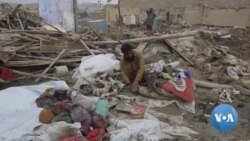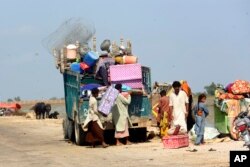Weeks of catastrophic flooding in Pakistan, triggered by climate change-driven erratic monsoon rains, have raised fears of acute food shortages and further spread of waterborne deadly diseases in the country of about 220 million people.
Pakistani officials estimate a third of the South Asian nation, an area the size of the United Kingdom, has been left underwater by the flooding, destroying almost half of its croplands.
The United Nations said Friday that the torrential rains "have broken a century-long record," dumping more than five times the 30-year average for rainfall in some provinces.
This has caused widespread flooding and landslides, with severe repercussions for human lives, property and infrastructure, according to the U.N. Office for the Coordination of Humanitarian Affairs.
"Initial estimates on the ground suggest that at least 3.6 million acres of crops/orchards across the country have already been affected. The livestock sector has also experienced severe losses, with over 733,000 livestock reportedly killed," it said.
Since mid-June, when seasonal rains began, more than 1,200 people have been killed, including 416 children, and at least 6,000 others have been injured. More than 1.1 million houses have been washed away or damaged, and 33 million residents in 80 hardest-hit districts will require some form of assistance, according to Pakistani officials.
Nearly 500,000 people are in relief camps, while many more are displaced and being hosted by other households.
The Pakistan military said Friday that its rescue teams had evacuated an additional 2,000 people from calamity-hit districts, bringing to 50,000 the total number of individuals moved to safer locations since rescue operations began.
Southwestern Baluchistan, southern Sindh and parts of central Punjab provinces have been badly hit by the floods.
The U.N. Population Fund says at least 650,000 pregnant women and girls, 73,000 of whom are expected to deliver in the next month, are among the victims. It says many of the women lack access to health care facilities and support they need to deliver their children safely.
"Most births in Pakistan happen at home, and with almost 1 million homes destroyed, many women don't know where they will deliver their babies," Human Rights Watch said Friday.
"Pakistan's disastrous floods highlight not only how the effects of the climate crisis are unevenly shared geographically, but also the disproportionate impact on women and girls," the group said.
Fears of more child deaths
Abdullah Fadil, the Pakistan representative of the U.N. Children's Fund (UNICEF), said Friday that at least 18,000 schools had been damaged or destroyed in the floods, which have affected an estimated 16 million children, including 3.4 million who need humanitarian support.
"Many children are now at heightened risk, without a home, school or even safe drinking water," Fadil said. "There is therefore a risk of many more child deaths. And the situation will only continue to deteriorate as winter is just eight weeks away in some parts of the country."
He said that communities were increasingly having to resort to open defecation without adequate sanitation, putting them at high risk of contracting diseases such as diarrhea, cholera, dengue and malaria.
Pakistani and U.N. officials said relief and rescue operations were still hard to conduct, noting that more than 5,000 kilometers of roads and 243 bridges had been damaged or destroyed by floodwaters.
"Yet lifesaving rescue and relief efforts are indispensable, and UNICEF is distributing humanitarian supplies in all affected provinces," Fadil said. The supplies include drinking water; hygiene kits; medicines; water purification tablets; vaccines; therapeutic food for children, pregnant and lactating women; and mosquito nets.
"The sad reality is, as we have seen all around the world, climate change is making extreme weather events more frequent and more destructive, and it is children who are too often paying the price."
Fadil noted that Pakistan ranks 14th out of 163 countries on UNICEF's Children's Climate Risk Index, placing the country in the "extremely high risk" category in the index.
'Monsoon on steroids'
The U.N. has appealed for $160 million in aid to help tackle what it said was an "unprecedented climate catastrophe."
U.N. Secretary-General Antonio Guterres will arrive in Pakistan on September 9 to visit flood-hit areas.
"The Pakistani people are facing a monsoon on steroids," Guterres said while speaking at the launch of the U.N. flash funding appeal on Tuesday.
"Let's stop sleepwalking towards the destruction of our planet by climate change. Today, it's Pakistan. Tomorrow, it could be your country," he warned.
Weather officials forecast more rains and flash flooding during September, raising fears that wheat-growing famers would be unable to have their croplands free of floodwaters by early October when they undertake planting.
"If floodwaters recede by that time, sowing might be possible, but if floods continued to inundate areas in Sindh and Punjab, then it's highly likely that critical wheat shortage may occur in Pakistan," said Mohsin Hafeez, the country representative for the International Water Management Institute.
"Such a situation may force the [Pakistan] government to import more wheat from the global market, which will add pressure on the existing import bill." Hafeez told VOA that global wheat prices have risen since the outbreak of the Ukraine war, and a low crop output in Pakistan would add to the financial troubles facing the cash-starved Pakistani government.
Meanwhile, more humanitarian relief flights arrived on Friday from countries such as Qatar and the United Arab Emirates. China, the United States, France, Iran, Britain, Azerbaijan, Norway and Kazakhstan are among the countries that have provided or pledged flood relief aid to Pakistan.
The U.S. military said Friday that it was sending an assessment team to Pakistan to determine what support it could offer through the U.S. Agency for International Development as part of Washington’s response to the flooding crisis.
General Michael Kurilla, head of U.S. Central Command, said in a statement that he discussed the matter by phone with Pakistan’s army chief, General Qamar Javed Bajwa, and expressed "his condolences for the people of Pakistan."










